The 2010 December Daring Bakers’ challenge was hosted by Penny of "Sweet Sadie’s Baking" who chose to challenge Daring Bakers’ to make a "Dresdner Christstollen". She adapted a friend’s family recipe and combined it with information from friends, techniques from Peter Reinhart’s book and Martha Stewart’s demonstration.
"Dresndner Christstollen" is a bread-like fruitcake made with yeast, water, milk, flour, butter, salt, eggs, rum, vanilla, orange essence, orange and lemon zests, candied orange peel, candied citrus peel, raisins, cinnamon and sometimes also cardamom as well as marzipan. This traditional German speciality which is a little similar to the Italian "Panettone" or the Dutch "Kerststol" can be traced back to 1474. It is usually eaten during the Christmas holidays, hence the religious-oriented name (it is also called "Weihnachtsstollen", meaning "Christmas Stollen" in English). Originally it was called "Dresdner Striezel" - "Striezel" coming from the word "Strüzel" or "Stroczel", meaning "awaken" because it was an early-baked loaf of bread. It's unique shape is meant to represent the baby Jesus wrapped in swaddling clothes.
Germans baked "Stollen" loaves to honor princes and church dignitaries, and to sell at fairs and festivals. The very first of them were confectioned without milk or butter because the Catholic church didn't allow these ingredients during Advent. It was only until the mid 17th century that a papal proclamation allowed bakers to finally add milk and butter.
Nowadays it is still as popular as in the past. Although "Dresdner Christstollen" doesn't have roots in Switzerland we nontheless consume tons of that festive treat during the end of year festivities. It is so widely spread that you can buy it from every store and you'll find it on most tables. At home we always ate "Stollen", so now I cannot imagine celebrating Yuletide without serving that ambrosial goodie. It is so Xmas-like. Therefore, when I heard that we were asked to bake a "Stollen" for the December challenge I was really excited about that project and really looked forward to tasting the homemade version as until now I have never had the opportunity to make my own.
I more or less followed the recipe to the letter. I chose not to use candied cherries, but added a few more raisins. As I thought that almond flakes might totally disappear in the dough and would pass unnoticed if used in that form I decided to add slivered almond instead which I toasted. I also filled one of my loaves with some marzipan. Being a traditionalist, I absolutely wanted to shape my "Dresdner Christstollen" the classic way and didn't have the desire to give it the appearance of a wreath.
The result was highly satisfying. The recipe gave me two mammoth loaves that looked perfect and tasted just out of this world. My "Dresdner Christstollen" had just the right texture too. It was neither too heavy nor too light, the inside was pleasantly moist and melt-in-the-mouth and and the crust was super soft (there was nearly no difference with the inside). Flavor-wise they were exactly the way they should be: intensely fragrant, with delicate boozy, buttery, orangy, lemony, cinnamony and nutty notes, not to forget that thanks to the overnight proofing they also had a slightly sourdoughy aroma that was extremely pleasurable. There is only one negative remark I'll make though. In my opinion, the "Stollen" could have contained more raisins and mixed peel as I found there were a tad not enough fruits...
This homemade "Dresdner Christstollen" is so much better than store-bought ones and a lot cheaper, so I highly recommend you to get off your asses and start baking if you love this European delicacy!
Recipe adapted from Penny's German friend who bakes Stollen every year, Peter Reinhart's "Bread Baker’s Apprentice" and Martha Stewart.
Makes two traditional shaped Stollen loaves.
Serves 10-12 people
Preparation time:
The following times are approximate. I suggest you gather and scale/weigh/measure (mise en place) all your ingredients before you begin mixing.
• Approximately 1 hour first stage – then rest overnight or up to 3 days
• 2 hours to warm up after refrigeration
• 15 minutes shaping
• 2 hours proofing
• 30-45 minutes baking Equipment required:
• Mixer with dough hook or strong arms and hands
• Mixing bowl
• Bowl to soak raisins
• Small saucepan
• Sheet of plastic or plastic wrap to cover when proofing
• Bench or pastry scraper (very handy for cutting dough and also cleaning work surface)
• Rolling pin
• Dough whisk can be handy but not necessary
• Pastry Brush
• A scale is really important to have when making bread so I strongly advise you to get one. You do not have to have one though. (would make a good Christmas gift!)
• Sheet Pan or round Pizza pan
• Parchment Paper Stollen Wreath
Ingredients:
1/4 Cup (60ml) Lukewarm water (110º F/43º C)
2 packages (4 1/2 Tsps/14 grams/1/2oz) Active dry yeast
1 Cup (240ml) Milk
10 Tbs (140g) Unsalted butter (can use salted butter)
5½ Cups (27oz/770g) All-purpose flour (Measure flour first, then sift + extra for dusting)
½ Cup (115g) Castor sugar
¾ Tsp (4.5g) Sea salt (if using salted butter there is no need to alter this salt measurement)
1 Tsp (6g) Gropund cinnamon
3 Large eggs, lightly beaten
Grated zest of 1 lemon and 1 orange
2 Tsps Pure vanilla extract
1 Tsp Lemon extract or orange extract
3/4 Cup (4 ¾oz/135g) Mixed peel
1 Cup (6oz/170g) Firmly packed raisins
3 Tbs (45ml) Dark rum
12 Red glacé cherries, roughly chopped (optional)
1 Cup (3.5oz/100g) Slivered almonds, lightly toasted
Melted unsalted butter for coating the wreath
Confectioners sugar for dusting wreath
Note:
If you don’t want to use alcohol, double the lemon or orange extract or you could use the juice from the zested orange.
Method For Making The "Dough":
1. In a small bowl, soak the raisins in the rum (or in the orange juice from the zested orange) and set aside.
2. Pour 1/4 cup (60 ml) warm water into a small bowl, sprinkle with yeast and let stand 5 minutes. Stir to dissolve yeast completely.
3. In a small saucepan, combine 1 cup (240 ml) milk and 10 tablespoons (150 ml) butter over medium - low heat until butter is melted. Let stand until lukewarm, about 5 minutes.
4. Lightly beat eggs in a small bowl and add lemon and vanilla extracts.
5. In a large mixing bowl (4 qt/4 liters or in the bowl of an electric mixer with paddle attachment), stir together the flour, sugar, salt, cinnamon, orange and lemon zests.
6. Then stir in (or mix on low speed with the paddle attachment) the yeast/water mixture, eggs and the lukewarm milk/butter mixture (This should take about 2 minutes. It should be a soft, but not sticky ball).
7. When the dough comes together, cover the bowl with either plastic or a tea cloth and let rest for 10 minutes.
8. Add in the mixed peel, soaked fruit and almonds and mix with your hands or on low speed to incorporate. Here is where you can add the cherries if you would like (Be delicate with the cherries or all your dough will turn red!).
9. Sprinkle flour on the counter, transfer the dough to the counter, and begin kneading (or mixing with the dough hook) to distribute the fruit evenly, adding additional flour if needed (The dough should be soft and satiny, tacky but not sticky). Knead for approximately 8 minutes/6 minutes by machine (The full six minutes of kneading is needed to distribute the dried fruit and other ingredients and to make the dough have a reasonable bread-dough consistency. You can tell when the dough is kneaded enough – a few raisins will start to fall off the dough onto the counter because at the beginning of the kneading process the dough is very sticky and the raisins will be held into the dough but when the dough is done it is tacky which isn't enough to bind the outside raisins onto the dough ball.).
10. Lightly oil a large bowl and transfer the dough to the bowl, rolling around to coat it with the oil. Cover the bowl with plastic wrap.
11. Put it in the fridge overnight (The dough becomes very firm in the fridge since the butter goes firm, but it does rise slowly… The raw dough can be kept in the refriger ator up to a week and then baked on the day you want.).
Shaping the Dough and Baking the Wreath:
1. Let the dough rest for 2 hours after taking out of the fridge in order to warm slightly.
2. Line a sheet pan with parchment paper.
3. Punch dough down, divide it into two pieces.
4. Pat into ovals.
5. For traditional stollen shape (video 1 & video 2), on a floured working surface roll out the dough to an oblong shape about 3 cm (1 1/5 inch) thick (The long sides should be bulging.). Fold in the long sides of the dough on top of each other. Now push in the dough lengthwise with your hands forming a stollen shape. Place the Stollen on your baking sheet.
6. Brush the dough with melted butter and cover loosely with plastic wrap.
7. Proof for approximately 2 hours at room temperature, or until about 1 1/2 times its original size.
8. Preheat oven to moderate 180°C (350° F) with the oven rack on the middle shelf.
9. Bake the stollen for 20 minutes, then rotate the pan 180 degrees for even baking and continue to bake for 20 to 30 minutes (The bread will bake to a dark mahogany color, should register 190°F/88°C in the center of the loaf, and should sound hollow when thumped on the bottom.). 10. Transfer to a cooling rack and brush the top with melted butter while still h ot.
11. Immediately tap a layer of powdered sugar over the top through a sieve or sifter.
12. Wait for 1 minute, then tap another layer over the first (The bread should be coated generously with the powdered sugar. Coat the stollen in butter and icing sugar three times, since this many coatings helps keeps the stollen fresh - especially if you intend on sending it in the mail as Christmas presents! The more rum and the more coatings of butter and sugar you use the longer it will store. The following is for the recipe as written and uses the 45 mls of rum and two coatings of butter and icing sugar.).
13. Let cool at least an hour before serving.
Storing:
When completely cool, store in a plastic bag or leave it out uncovered overnight to dry out slightly, German style.
The stollen tastes even better in a couple of days.
Serving suggestions:
Stollen is delicious with butter and a cup of tea.
It toasts superbly and can be used to make bread pudding.
~~~~~~~~~~~~~~~~~~~~~~
Etant donné que la recette est un peu longue, je n'ai malheureusement pas pu faire une traduction française de ce billet et je m'en excuse auprès de tous mes amis lecteurs et blogueurs francophones!
C'est pourquoi je vous suggère de vous rendre sur le blog mentionné ci-desso us. Vous y trouverez cette recette en version française.
Recette pour le "Dresdner Christstollen" sur les deux blogs canadiens suivants:
Chez Isa de "Les Gourmandises d'Isa" (Canada)
Chez Vibi de "La Casserole Carrée" (Canada)

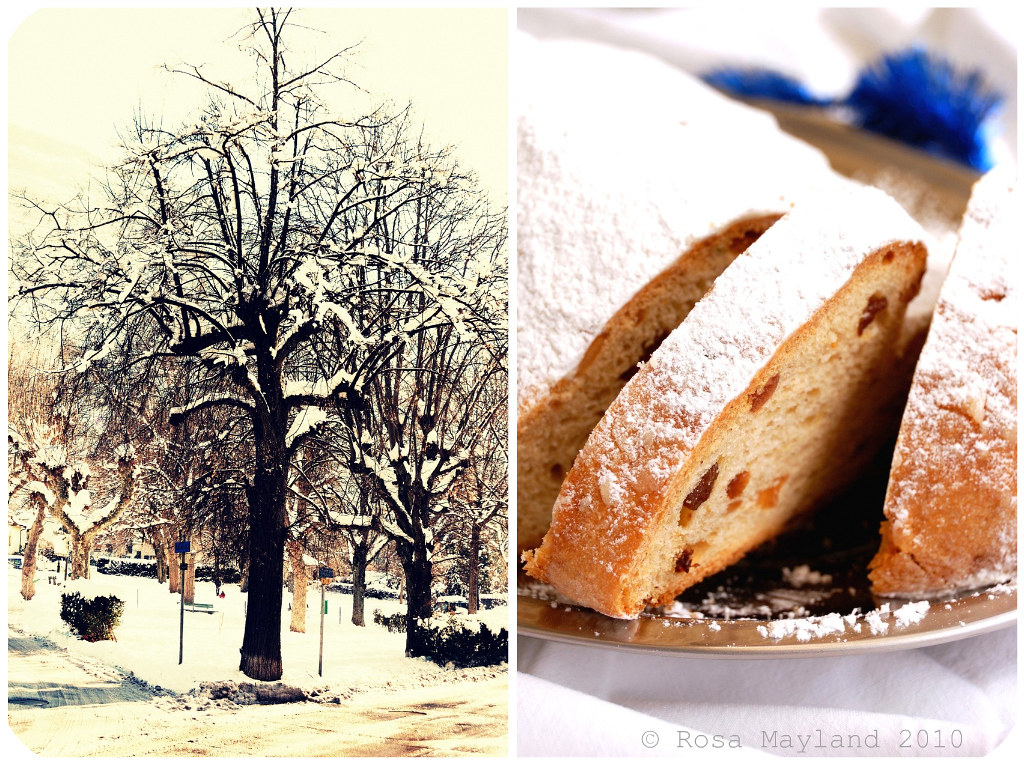

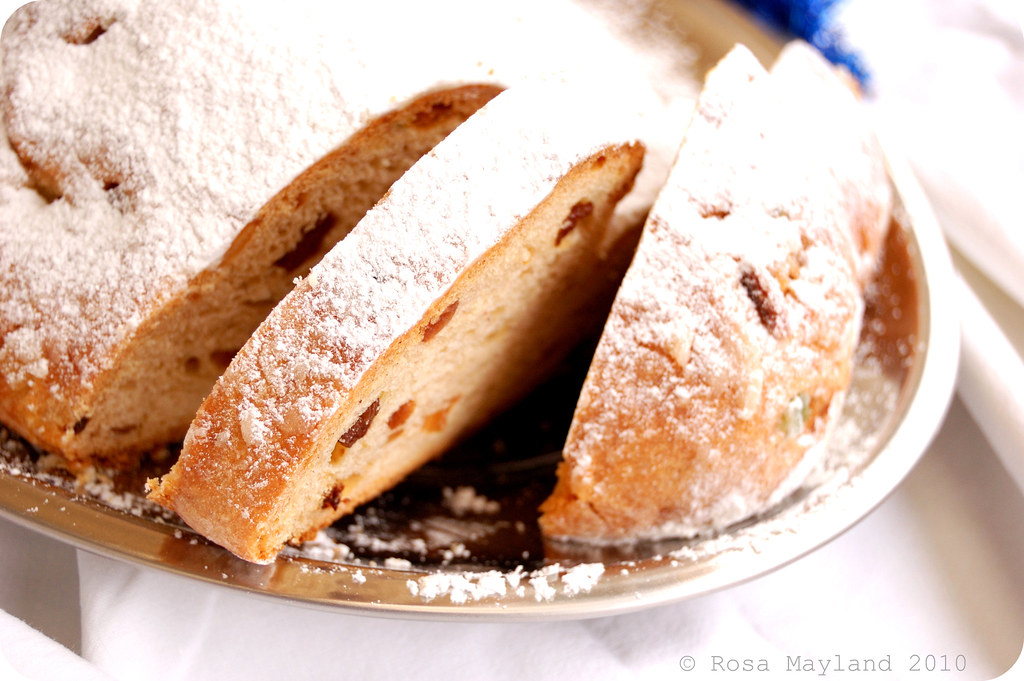
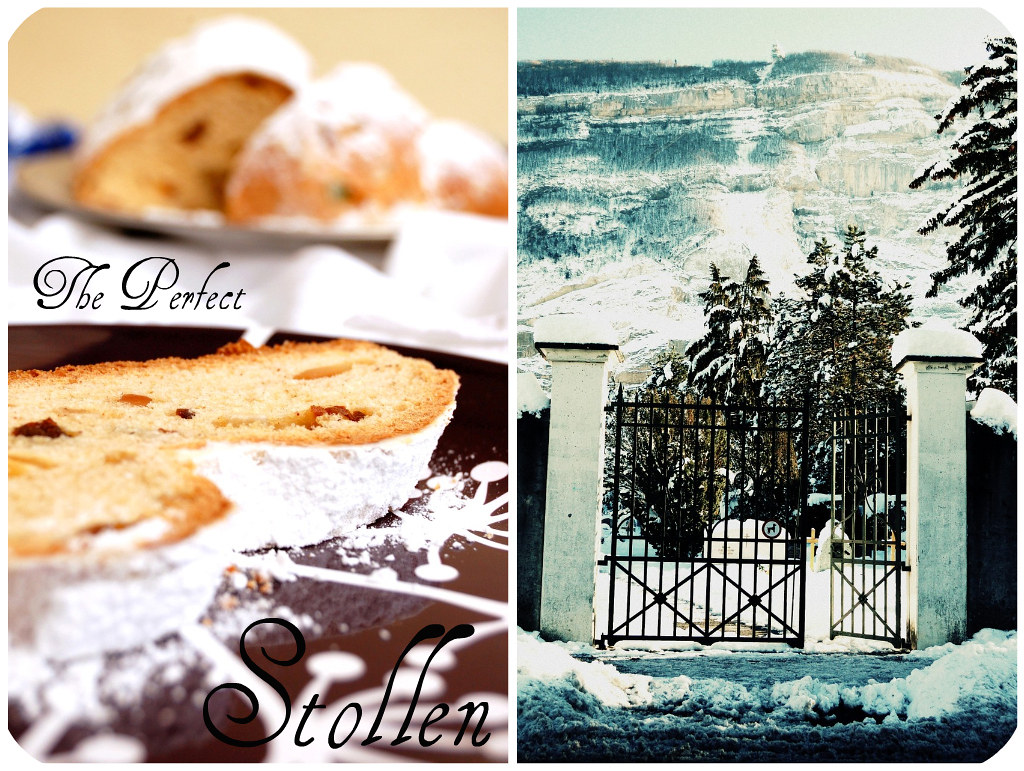
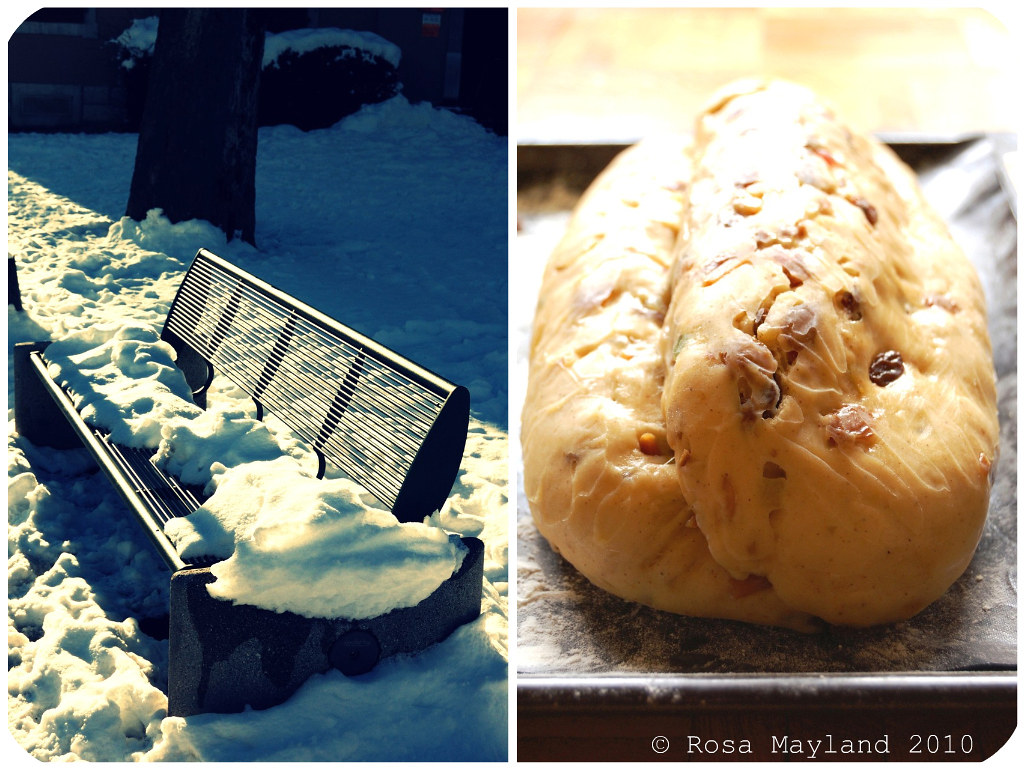
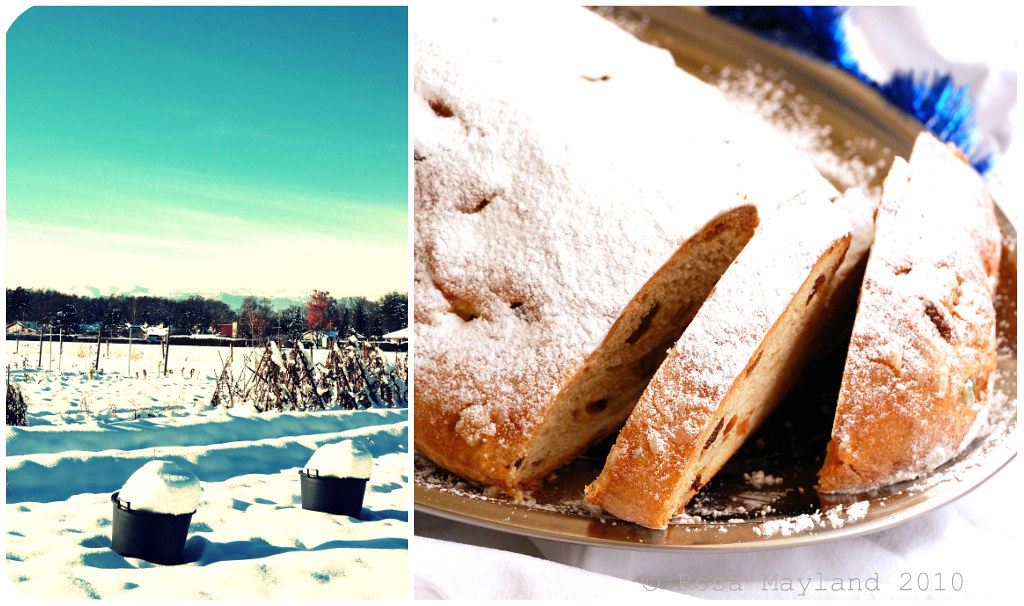
0 comments:
Post a Comment